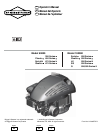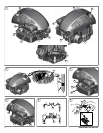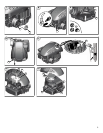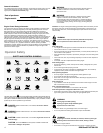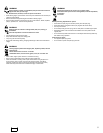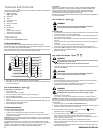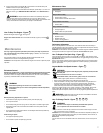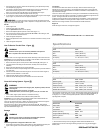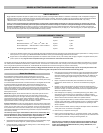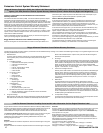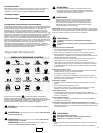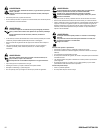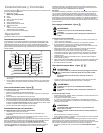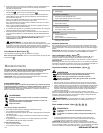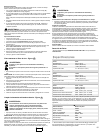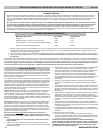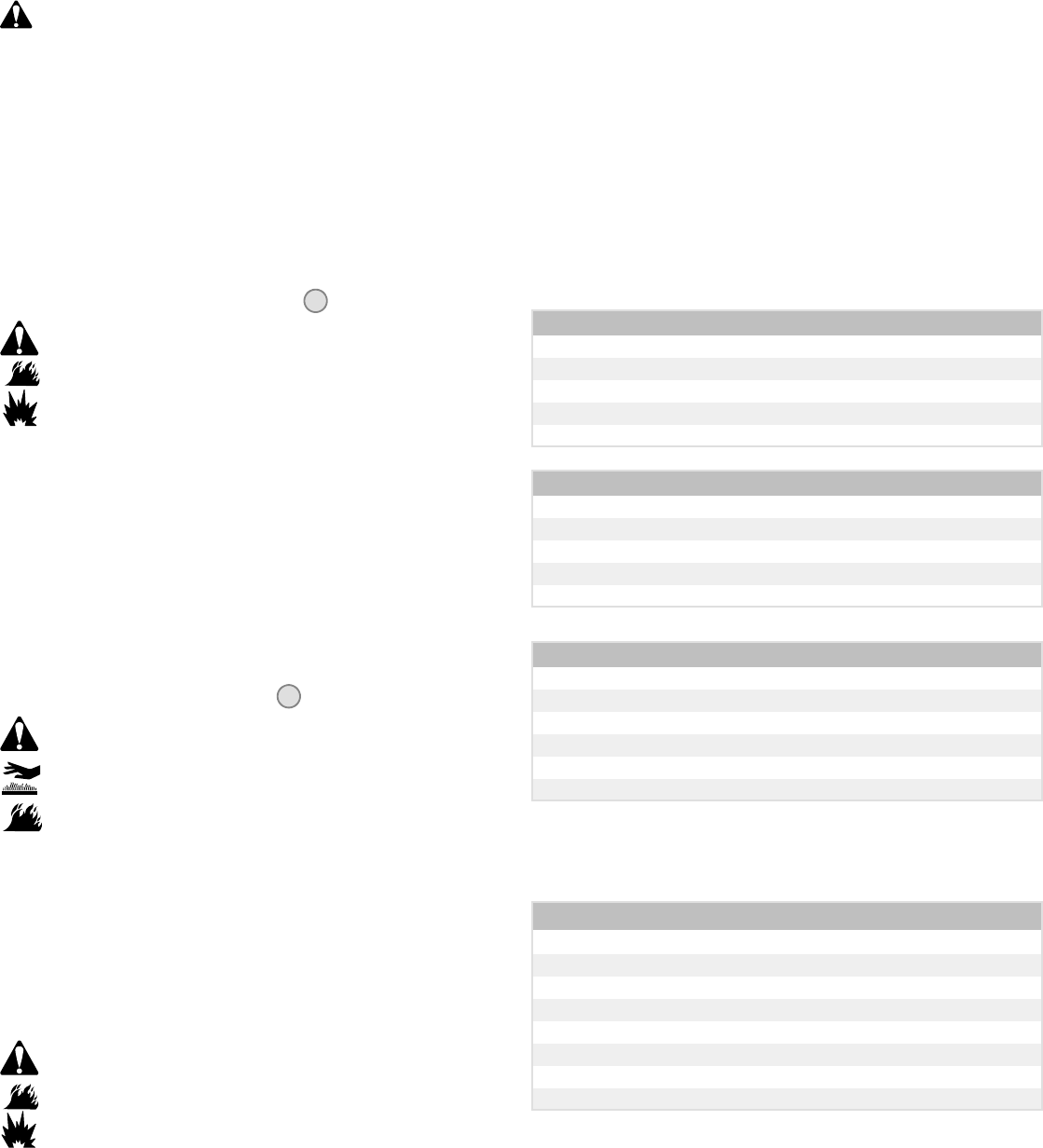
8
BRIGGSandSTRATTON.COM
1. With engine off but still warm, disconnect the spark plug wire (A) and keep it away
from the spark plug (Figure 8).
2. The engine is equipped with a bottom drain (B, Figure 9) and/or a side drain (C).
Remove the oil drain plug. Drain the oil into an approved container.
Note: Any of the oil drain plugs (D) shown may be installed in the engine.
3. After the oil has drained, install and tighten the oil drain plug.
4. If you drain the oil from the top oil fill tube (E), keep the spark plug end of the engine
(F) up (Figure 10). Drain the oil into an approved container.
WARNING: If you drain the oil from the top oil fill tube, the fuel tank must be
empty or fuel can leak out and resultin a fire or explosion. To empty the fuel tank, run the
engine until it stops from lack of fuel.
Add Oil
• Place engine level.
• Clean the oil fill area of any debris.
• See the Specifications section for oil capacity.
1. Remove the dipstick (G) and wipe with a clean cloth (Figure 11).
2. Pour the oil slowly into the engine oil fill (H). Do not overfill. After adding oil, wait
one minute and then check the oil level.
3. Install and tighten the dipstick.
4. Remove the dipstick and check the oil level. It should be at the FULL mark (J)onthe
dipstick.
5. Install and tighten the dipstick.
How To Service The Air Filter - Figure
12
WARNING
Gasoline and its vapors are extremely flammable and explosive.
Fire or explosioncan cause severe burns or death.
• Never start or run the engine with the air cleaner assembly or the air filter removed.
CAUTION: Do not use pressurized air or solvents to clean the filter. Pressurized air can
damage the f ilter and solvents will dissolve the filter.
1. Remove the screw (A) from the top of the air filter assembly (B). See Figure 12.
2. To prevent debris from falling into the carburetor, carefully remove the air filter
assembly.
3. Remove the foam element (C) from the air filter base.
4. Wash the foam element in liquid detergent and water. Squeeze dry the foam element
in a c lean cloth.
5. Saturate the foam element with clean engine oil. To remove the excess engine oil,
squeeze the foamelement in a clean cloth.
6. Install the foam element into the air filter base.
7. Install the air filter assembly onto the carburetor and secure with screw.
Clean Air Cooling System - Figure
13
Running engines produce heat. Engine parts, especially muffler, become
extremely hot.
Severe thermal burns can occur on contact.
Combustible debris, suchas leaves, grass, brush, etc. can catch fire.
WARNING
• Allow muffler, engine cylinder and fins to cool before touching.
• Remove accumulated debris from muffler area and cylinder area.
CAUTION: Do not use water to clean the engine. Water could contaminate the fuel
system. Use a brush or dry cloth to clean the engine.
This is an air cooled engine. Dirt ordebris can restrict air flow and cause the engine to
overheat, resulting inpoor performance and reduced engine life.
Use a brush or dry cloth to remove debris from the finger guard (A). Keep linkage,
springs and controls (B) clean. Keepthe area around and behindthe muffler (C)freeof
any combustible debris (Figure 13).
Storage
Gasoline and its vapors are extremely flammable and explosive.
Fire or explosioncan cause severe burns or death.
WARNING
When Storing Gasoline Or Equipment With Fuel In Tank
• Store away from furnaces, stoves, water heaters or other appliances that have pilot
lights or other ignition sources because they can ignite gasoline vapors.
Fuel System
Fuel can become stale when stored over 30 days. Stalefuel causes acid and gum
deposits to form in the fuel systemor on essential carburetor parts. To keep fuel fresh,
use Briggs &Stratton FRESH START
®
fuel stabilizer, available as a liquid additive or a
drip concentrate cartridge.
There is no need to drain gasoline from the engine if a fuel stabilizer is addedaccording
to instructions. Run the enginefor 2 minutes to circulate the stabilizer throughout the fuel
system. The engine and fuel can then be stored up to 24 months.
If gasoline in the engine has notbeen treated with a fuel stabilizer,it must be drained into
an approved container. Run the engine until it stops from lack of fuel. The use of a fuel
stabilizer in the storage container is recommended to maintain freshness.
Engine Oil
While the engine is still warm, change the engine oil.
Troubleshooting
Need assistance? Go to BRIGGSandSTRATTON.COM or call 1-800-233-3723.
Specifications
Engine Specifications
Model 90000
Displacement 9.02 ci (148 cc)
Bore 2.562 in (65.08 mm)
Stroke 1.750 in (44.45 mm)
Oil Capacity 18 -- 20 oz (0.54 -- 0.59 L)
Engine Specifications
Model 100000
Displacement 9.67 ci (158 cc)
Bore 2.562 in (65.08 mm)
Stroke 1.875 in (47.65 mm)
Oil Capacity 18 -- 20 oz (0.54 -- 0.59 L)
Tune-up Specifications *
Model 90000, 100000
Spark Plug Gap 0.030 in (0.76 mm)
Spark Plug Torque 180 lb-in (20 Nm)
Armature Air Gap 0.006 - 0.010 in (0.15 - 0.25 mm)
Intake Valve Clearance 0.005 - 0.007 in (0.13 - 0.18 mm)
Exhaust Valve Clearance 0.007 - 0.009 in (0.18 - 0.23 mm)
* Engine power will decrease 3.5% for each 1,000 feet (300 meters) above sea leveland
1% for each 10° F(5.6° C) above 77° F(25° C). The engine will operate satisfactorily at
an angle up to 15°. Refer to the equipment operator’s manual for safe allowable
operating limits on slopes.
Common Service Parts n
Service Part Part Number
Flat Air Filter 698369
Oil -- SAE 30 100005
Fuel Additive 5041, 5058
Resistor Spark Plug 802592, 5095
Long Life Platinum Spark Plug 5062
Spark Plug Wrench 89838, 5023
Spark Tester 19368
n We recommend that you see any Briggs & Stratton Authorized Dealer for all
maintenance and service of the engine and engine parts. Use only genuine Briggs &
Stratton parts.



